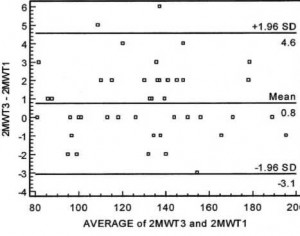Reliability, Validity, and Responsiveness of a 2-Min Walk Test To Assess Exercise Capacity of COPD Patients: Test for Reliability
Of the 47 subjects who were initially recruited to the study, two subjects dropped out because they had exacerbations during the assessment period. Demographic and anthropomorphic data, and pulmonary function test and exercise test results are shown in Tables 1, 2. Forty-five subjects (37 men and 8 women; mean age, 71.8 ± 8.3 years; mean FEV1, 41.9 ± 13.0% predicted) completed the study. There were significant increases in RPDs and RPEs after pulmonary rehabilitation for both the 2MWT and 6MWT. The magnitudes of RPDs and RPEs were comparable to those of other studies. Small but significant differences in the end of test RPEs between the 2MWT and the 6MWT indicated that the 6MWT was more exhausting to perform than the 2MWT (mean RPE in 2MWT, 3.0 ± 2.0; mean RPE in 6MWT, 3.3 ± 0.3; p < 0.05).
The mean distances walked during the three 2MWTs were 129.5 ± 28.7, 129.8 ± 28.8, and 130.3 ± 28.7 m, respectively (Table 3). The high intraclass correlation coefficient (R = 0.9994; p < 0.05) indicated that the repeated measurements were highly correlated, thus confirming its high reliability. Here
The mean differences among trials were illustrated in Figures 1 to 3. The mean increases were 0.3 to 0.8 m with limits of agreement in the 95% confidence interval ranging from -3.1 to 4.6 m. These were very small variations compared with the mean 2MWT distances. Therefore, we can conclude that the reliability of the 2MWT in terms of limits of agreement was high. Correlations between the 2MWT and the different measures of exercise capacity (ie, 6MWT, V02max, V02max/kg, and Wmax) are shown in Table 4. Since four statistical tests were conducted, a Bonferroni adjustment was performed to minimize the type 1 error. Therefore, the significance level was set at 0.0125 (0.05/4).
Table 4 illustrates the significant correlations found between the 2MWT and 6MWT, the V02max, and the V02max/kg respectively (all p < 0.0125). A very high correlation was found between the 2MWT and the 6MWT (r = 0.937), whereas modest correlations were found between the 2MWT and the Vo2max (r = 0.454), and the 2MWT and the Vo2max/kg (r = 0.555).
Table 1—Demographic and Anthropomorphic Data and Pulmonary Function
| Variables (n = 45) | Values |
| Age, yr | 71.8 ± 8.3 |
| Body weight, kg | 54.1 ± 10.6 |
| Body height, m | 1.62 ± 0.08 |
| BMI, kg/m2 | 20.76 ± 3.97 |
| FVC, L | 2.01 ± 0.48(71.6 ± 11.5) |
| FEVb L | 0.88 ± 0.27 (41.9 ± 13.0) |
| FEVj/FVC ratio, % | 44.8 ± 11.2 |
| RV, L | 4.98 ± 2.14 (217.8 ± 88.0) |
| TLC, L | 7.07 ± 2.40 (130.3 ± 37.3) |
| Dlco, mL/min/mm Hg | 7.58 ± 3.73 (37.1 ± 16.2) |
Table 2—Exercise Test Results
| Variables (n = 45) | Mean (SD) |
| 2MWT, m | 130.8 (28.8) |
| RPD | |
| pre-2MWT | 0.1 (0.4) |
| post-2MWT | 3.0 (2.2) |
| RPE | |
| pre-2MWT | 0.2 (0.4) |
| post-2MWT | 3.0 (2.0) |
| 6MWT, m | 365.4 (91.9) |
| RPD | |
| pre-6MWT | 0.2 (0.6) |
| post-6MWT | 3.3 (2.1) |
| RPE | |
| pre-6MWT | 0.2 (0.6) |
| post-6MWT) | 3.3 (0.3) |
| Vo2max, mL/min | 541.39(183.91) |
| Vo2max/kg, mL/kg/min | 9.91 (2.63) |
| Wmax, W | 33.07 (14.45) |
Table 3—Distance Walked in Three Trials of 2MWT and the Intraclass Correlation Coefficient of the Three Trials
| Variables (n = 45) | Mean (SD) |
| 2MWT | |
| Trial 1 | 129.5 (28.7) |
| Trial 2 | 129.8 (28.8) |
| Trial 3 | 130.3 (28.7) |
| ICC | 0.9994 |
Table 4—Correlations Between 2MWT and Different Measures of Exercise Capacity
| Variables | r Value | p Value |
| 6MWT, m | 0.937* | 0.000 |
| ‘Vo2max, mL/min | 0.454* | 0.002 |
| Vo2max/kg, mL/kg/min | 0.555* | 0.000 |
| Wmax, W | 0.319 | 0.035 |
Figure 1. Differences in 2MWT results between trials 1 and 2.
Figure 2. Differences in 2MWT results between trials 2 and 3.
Figure 3. Differences in 2MWT results between trials 1 and 3.



Leave a Reply